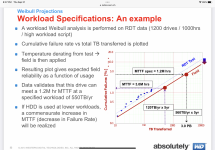nickw_
Cadet
- Joined
- May 9, 2023
- Messages
- 9
Hello All,
New to the forum, but I have been quietly reading for awhile.
I am continuing to learn about ZFS and TrueNAS, and I have a general question about using two-disk mirror vdevs. As hard disk capacities increase, is there a point where two disk mirrored vdevs stop making sense? In terms of having a URE's or drive failures start during a resilver?
To paint a hypothetical situation, lets say a 12 disk pool, comprised of 6x mirrored vdev's. Used doing typical homelab type tasks, around 50% full, using pro drives, where someone backs up to the cloud. So even though a backup is available, it's a pain to pull large amounts of data down.
I read many articles* and posts talking about benefits of different vdev's types. But I can't help but wonder as hard disk capacities grow, will we eventually outgrow 2 disk mirrors being considered a good practice? Similar to how raid5/z1 vdev's are no longer considered good practice?** I can't help but wonder if the days of 2disk mirrors coming to an end.
Again, this is a general question and I'm trying to learn. I've tried to do my homework with the recommend readings (and then some), but I don't see this addressed anywhere. I have also tried searching, but haven't found a solid discussion on the topic.
From what I can find, meta data is already duplicated on each drive, so thats more likely safe. But an URE in a file seems like a real concern. As do the long rebuild times as capacities grow. They could start taking 12+ hours and becoming very taxing on the remaining drive.
Thoughts? Experiences?
Thanks,
Nick
Links:
* https://jrs-s.net/2015/02/06/zfs-you-should-use-mirror-vdevs-not-raidz/
** https://www.zdnet.com/article/why-raid-5-stops-working-in-2009/
New to the forum, but I have been quietly reading for awhile.
I am continuing to learn about ZFS and TrueNAS, and I have a general question about using two-disk mirror vdevs. As hard disk capacities increase, is there a point where two disk mirrored vdevs stop making sense? In terms of having a URE's or drive failures start during a resilver?
To paint a hypothetical situation, lets say a 12 disk pool, comprised of 6x mirrored vdev's. Used doing typical homelab type tasks, around 50% full, using pro drives, where someone backs up to the cloud. So even though a backup is available, it's a pain to pull large amounts of data down.
I read many articles* and posts talking about benefits of different vdev's types. But I can't help but wonder as hard disk capacities grow, will we eventually outgrow 2 disk mirrors being considered a good practice? Similar to how raid5/z1 vdev's are no longer considered good practice?** I can't help but wonder if the days of 2disk mirrors coming to an end.
Again, this is a general question and I'm trying to learn. I've tried to do my homework with the recommend readings (and then some), but I don't see this addressed anywhere. I have also tried searching, but haven't found a solid discussion on the topic.
From what I can find, meta data is already duplicated on each drive, so thats more likely safe. But an URE in a file seems like a real concern. As do the long rebuild times as capacities grow. They could start taking 12+ hours and becoming very taxing on the remaining drive.
Thoughts? Experiences?
Thanks,
Nick
Links:
* https://jrs-s.net/2015/02/06/zfs-you-should-use-mirror-vdevs-not-raidz/
** https://www.zdnet.com/article/why-raid-5-stops-working-in-2009/

